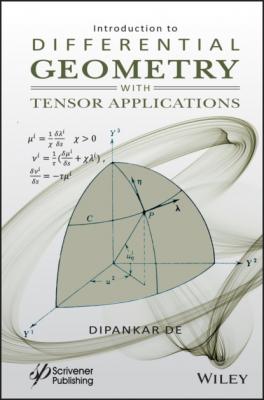Introduction to Differential Geometry with Tensor Applications. Группа авторов
Чтение книги онлайн.
Читать онлайн книгу Introduction to Differential Geometry with Tensor Applications - Группа авторов страница 10
 P and Q be two points of E2, with (x1, x2) and (y1, y2) as their respective coordinates. Then, the coordinates of the directed line segment
P and Q be two points of E2, with (x1, x2) and (y1, y2) as their respective coordinates. Then, the coordinates of the directed line segment Denoting x1 − y1 and x2 – y2 by z1 and z2 respectively, the coordinates of
(0.1)
Next, we consider an orthogonal transformation of coordinate axes given by
where
We can express (0.2) as follows:
denoted by (x1, x2) and (y1, y2), the coordinates of Q and P in the new coordinates system. Then, the coordinates of vector
Hence, Equation (0.4) can be written as
(0.5)
[from Equation (0.3) we get
The above equation shows that the coordinates of a vector
This was first pointed out by Felix Klein in 1872.
Similarly, if we consider n vectors, it can be shown that there exists an object with components
(0.7)
Hence, we conclude that a tensor of E2 may be regarded as generalization of a vector of E2 defined from the transformation law. Similarly, a tensor of En can be obtained as a generalization of a vector of En. A tensor obtained from the orthogonal transformation of a rectangular Cartesian coordinate system is called a Cartesian Tensor and a tensor from a general transformation coordinate system is simply called a tensor.
The flourishing of the subjects of tensors and Differential Geometry and Mechanics is due to Einstein and Grassman. Then, many mathematicians and researchers developed Differential Geometry with tensor applications.
Sasaki and Hsu defined and studied almost all contact structures and their integrability conditions. In 1970, Yano and Okumura studied structure manifold and Walker, A.G. (1955) studied the properties of the manifold (λu, v,) with an almost product structure in which there exists a (1,1) tensor field, f, whose square is unity. K. Yano (1963) generalized the concept of an almost complex structure and defined f-structures as a (1,1) tensor field f (satisfying f3 + f = 0). In 1972, K. Kenmotsu studied a certain class of an almost contact manifold. Janssen and Vanhecke (1981) named this structure a Kenmotsu structure and the differentiable manifold equipped with this structure is called a Kenmotsu manifold. Many authors have studied slant immersions in almost Hermitian manifolds. The study of Differential Geometry of tangent and cotangent bundles was started by Sasaki (1958) and then Yano and Davies and Ledger. The theory of submanifolds as a field of Differential Geometry is as old as Differential Geometry itself. A study of the submanifolds of a manifold is a very interesting field of Differential Geometry. In 1981, B.Y. Chen, D.E. Blair, A. Bejancu, M.H. Sahid (1994-95), and some others studied different properties of submanifolds. Sasaki (1960) and others studied differentiable manifolds in detail.
Differential Geometry is the study of geometric properties of curves, surfaces, and their higher dimensional analogues using the methods of Tensor Calculus. For the study of curve by this method of calculus, its parametric representation is a covariant and discuss tangent and normal and binormal, which is of fundamental importance to the theory of the curve. We will study the geometric properties of surface imbedded in the three-dimensional Euclidean space by means of Differential Geometry, termed as intrinsic properties and intrinsic geometry of surface. The study of the geometry of surfaces was carried out from the point of view of a two-dimensional being whose universe is determined by the surface parameters u1 and u2 and it was based entirely on the study of the first quadratic differential form.
Differential Geometry has a long and rich history and, in addition to its intrinsic mathematical value and important connections with various other branches of mathematics, it has many applications in various physical sciences, e.g., solid mechanics, computer tomography, and general relativity. Differential Geometry is a building block in Physics and Classical Mechanics, which was developed extensively by Newton. It deals with the motion of particles in a fixed frame of reference. Within those frames, other coordinate systems may be used so long as the metric remains Euclidean. The reference system generally used in astronomy is determined by “fixed stars”. It is termed as the primary inertial system. The motion of the earth relative to its primary inertial system is so negligible that Newtonian laws which can be applied without modification to the study of motion of particles is referred to as a system of axes fixed in the earth.
1